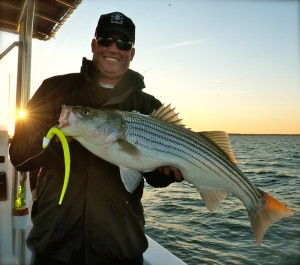 This week I’ve been fishing both north and south of Kent Island. I’m running along the deeper ledges looking for big birds either diving on breaking fish, flying high, or sitting. Since the fall turnover, the better fish have been feeding deep, sometimes thirty five feet deep or more. Once they round up a school of four to six inch bunker, they force them to the surface then explode into them knocking the hapless baitfish into the air where the gulls are waiting. The fish aren’t breaking in big pods but moving around in twenty to thirty fish rat packs. I usually only see a few splashes here and there to send down the birds. The predators move on quickly, so by the time you get to where you saw the splashes, they’re usually gone. The trick to catching them is to figure out what is attracting them to the location and try to anticipate their next move. While migratory stripers will feed wherever they find baitfish, this time of year they’re still running with Chesapeake residents so it’s more likely they are relating to underwater structure. That structure will probably be a live hard bottom near a steep subsurface ledge, especially ledges located near the mouths of tributary rivers. So when big fish are breaking here and there and not really schooled up, the best bet is to simply set up a drift near the ledge and wait for them to come to you. Read More!
This week I’ve been fishing both north and south of Kent Island. I’m running along the deeper ledges looking for big birds either diving on breaking fish, flying high, or sitting. Since the fall turnover, the better fish have been feeding deep, sometimes thirty five feet deep or more. Once they round up a school of four to six inch bunker, they force them to the surface then explode into them knocking the hapless baitfish into the air where the gulls are waiting. The fish aren’t breaking in big pods but moving around in twenty to thirty fish rat packs. I usually only see a few splashes here and there to send down the birds. The predators move on quickly, so by the time you get to where you saw the splashes, they’re usually gone. The trick to catching them is to figure out what is attracting them to the location and try to anticipate their next move. While migratory stripers will feed wherever they find baitfish, this time of year they’re still running with Chesapeake residents so it’s more likely they are relating to underwater structure. That structure will probably be a live hard bottom near a steep subsurface ledge, especially ledges located near the mouths of tributary rivers. So when big fish are breaking here and there and not really schooled up, the best bet is to simply set up a drift near the ledge and wait for them to come to you. Read More!
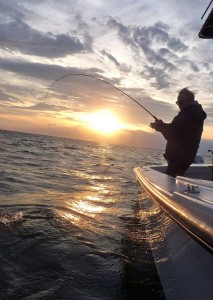 Savvy Chesapeake anglers recognize an event that happens every fall that has significant impact on light tackle fishing. In summer months, the waters in most areas of the Chesapeake Bay stratify so that it is cooler, denser, and saltier down deep, but lighter and fresher near the surface. In the fall, as temperatures cool and strong cold fronts bring lots of wind, the water is stirred up so that the top layer eventually reaches the same density as it is down deep. When that happens the surface water sinks so that for a while, temperatures and salinity are about the same top to bottom. It doesn’t happen all over the Bay at the same time, but it’s easily recognizable to fishermen because we start noticing that fish are feeding at much deeper depths. In some parts of the Maryland portion of the Bay, we are currently experiencing the fall turnover. This can be both good and bad for fishing.
Savvy Chesapeake anglers recognize an event that happens every fall that has significant impact on light tackle fishing. In summer months, the waters in most areas of the Chesapeake Bay stratify so that it is cooler, denser, and saltier down deep, but lighter and fresher near the surface. In the fall, as temperatures cool and strong cold fronts bring lots of wind, the water is stirred up so that the top layer eventually reaches the same density as it is down deep. When that happens the surface water sinks so that for a while, temperatures and salinity are about the same top to bottom. It doesn’t happen all over the Bay at the same time, but it’s easily recognizable to fishermen because we start noticing that fish are feeding at much deeper depths. In some parts of the Maryland portion of the Bay, we are currently experiencing the fall turnover. This can be both good and bad for fishing.
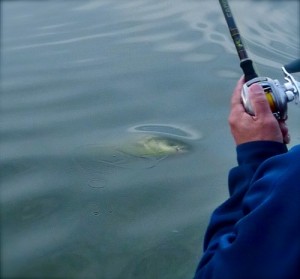 Like most Chesapeake Bay fishermen, my passion for fishing comes with a cost. I’m not speaking of tangibles like the money we put into gasoline, fishing lures, or repairing broken rods. That’s to be expected. The cost for the Chesapeake angler is worrying that the fish we love to catch may soon disappear. This week the Maryland Department of Natural Resources released its annual Young of the Year (YOY) Index. It’s an assessment of how many baby striped bass were produced the previous spring. This is the third year in a row that there has been less than normal reproduction. Marine biologists tell us there are a lot of reasons why the big fish aren’t making enough little fish. There are too many to list but it all boils down to one thing – uncertainty. We just don’t know what’s going on with our rockfish. The only thing we know for certain is that there will be a lot fewer fish for us to catch. Read More!
Like most Chesapeake Bay fishermen, my passion for fishing comes with a cost. I’m not speaking of tangibles like the money we put into gasoline, fishing lures, or repairing broken rods. That’s to be expected. The cost for the Chesapeake angler is worrying that the fish we love to catch may soon disappear. This week the Maryland Department of Natural Resources released its annual Young of the Year (YOY) Index. It’s an assessment of how many baby striped bass were produced the previous spring. This is the third year in a row that there has been less than normal reproduction. Marine biologists tell us there are a lot of reasons why the big fish aren’t making enough little fish. There are too many to list but it all boils down to one thing – uncertainty. We just don’t know what’s going on with our rockfish. The only thing we know for certain is that there will be a lot fewer fish for us to catch. Read More!
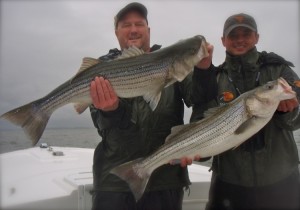 Here’s a quick update on the early-fall rockfish run we have going on now around Kent Island. I got out Thursday evening in the rain before the storm blew through. My partners were my brother-in-law Mitch and one of my regular fishing buddies, Dave. We got on the fish quickly and enjoyed an incredibly intense forty-five minutes, releasing one 30 inch rockfish after another. Mitch caught the best fish of the night, a pretty thirty-four incher. The fish turned off and we couldn’t buy another bite all night. Friday we had 30 knot winds, but we tried to fish. We couldn’t get to a lot of the places where we’ve found bigger fish, so we moved to more sheltered waters and caught only smaller ones. Saturday was a repeat of Friday with gusts up to gale force at times. We managed a few keepers and plenty of shorts in sheltered waters. Complicating things were very low water levels. North winds sometimes blow the water out of the Chesapeake basin into the Atlantic Ocean. Saturday evening’s low tide were as much as four feet below normal on the back side of Kent Island. Fortunately, conditions improved Sunday and the fish were right back where I wanted them to be. Read More!
Here’s a quick update on the early-fall rockfish run we have going on now around Kent Island. I got out Thursday evening in the rain before the storm blew through. My partners were my brother-in-law Mitch and one of my regular fishing buddies, Dave. We got on the fish quickly and enjoyed an incredibly intense forty-five minutes, releasing one 30 inch rockfish after another. Mitch caught the best fish of the night, a pretty thirty-four incher. The fish turned off and we couldn’t buy another bite all night. Friday we had 30 knot winds, but we tried to fish. We couldn’t get to a lot of the places where we’ve found bigger fish, so we moved to more sheltered waters and caught only smaller ones. Saturday was a repeat of Friday with gusts up to gale force at times. We managed a few keepers and plenty of shorts in sheltered waters. Complicating things were very low water levels. North winds sometimes blow the water out of the Chesapeake basin into the Atlantic Ocean. Saturday evening’s low tide were as much as four feet below normal on the back side of Kent Island. Fortunately, conditions improved Sunday and the fish were right back where I wanted them to be. Read More!
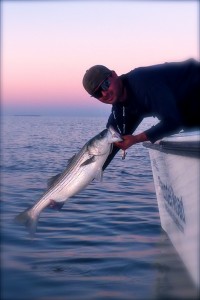 Since I’ve been reporting bigger migratory fish on my recent trips, I’ve been overwhelmed with questions about where the fish are. My apologies if I’ve yet to return a call or answer an email, but the absolute truth is – I don’t know. These big fish are moving around very quickly and they haven’t been at the same place twice. I think we sometimes put too much emphasis on locations, and not enough on patterns. Tell someone where to go to catch a fish and you may help them for a day, but teach them how to identify specific patterns of how fish behave, and you’ve helped them for a lifetime. Ask any good fisherman the secret to repeated success and he’ll tell you it’s the ability to distinguish specific feeding habits. I believe that you can drop a good fisherman into any body of water in the world and he’ll catch fish as long as you give him enough time to establish a prevailing pattern. It’s especially important on the Chesapeake where conditions change quickly and a rapid thirty degree temperature drop in October is not unusual. I think fishing conditions change faster and more often here than anywhere I’ve fished before. Fortunately, fish are usually creatures of habit and there are distinct patterns we can identify in the way they behave. Read More!
Since I’ve been reporting bigger migratory fish on my recent trips, I’ve been overwhelmed with questions about where the fish are. My apologies if I’ve yet to return a call or answer an email, but the absolute truth is – I don’t know. These big fish are moving around very quickly and they haven’t been at the same place twice. I think we sometimes put too much emphasis on locations, and not enough on patterns. Tell someone where to go to catch a fish and you may help them for a day, but teach them how to identify specific patterns of how fish behave, and you’ve helped them for a lifetime. Ask any good fisherman the secret to repeated success and he’ll tell you it’s the ability to distinguish specific feeding habits. I believe that you can drop a good fisherman into any body of water in the world and he’ll catch fish as long as you give him enough time to establish a prevailing pattern. It’s especially important on the Chesapeake where conditions change quickly and a rapid thirty degree temperature drop in October is not unusual. I think fishing conditions change faster and more often here than anywhere I’ve fished before. Fortunately, fish are usually creatures of habit and there are distinct patterns we can identify in the way they behave. Read More!
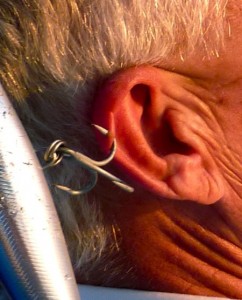 Ouch! Sunday night, my fishing partner Rich got a little too close to the top-water lure he’d left hanging on his rod in the console rod holder. The heavy duty treble hook went clean through. Even though he had mashed the barbs, it didn’t want to back out cleanly on those heavy duty saltwater hooks. More on that later….. If you’ve heard about big migratory fish with sea lice in the Bay, you heard right. I don’t know why they’re here, but I don’t see any reason to ask questions. They’re here so let’s enjoy them. I’ve fished three times since returning from my freshwater bass retreat to Tennessee. Each time we had big fish in shallow water. I’m fishing very close to home near Kent Island, sometimes within site of my house. I spent most of Saturday winterizing my boat and fishing gear. In my world, winterizing means preparing for big fish and rough water. I worked most of the day on the emergency gear in my boat but took the evening to upgrade the hooks and hardware on my top-water plugs. I also made sure I had plenty of good line on my reels, loaded my tackle bag with 10″ BKDs, and generally got things prepared for bigger fish. Saturdays are tough on the Bay, I think the fish hide on weekends, but on Sunday evening, sometimes they peek their heads out to see what’s going on. Read More!
Ouch! Sunday night, my fishing partner Rich got a little too close to the top-water lure he’d left hanging on his rod in the console rod holder. The heavy duty treble hook went clean through. Even though he had mashed the barbs, it didn’t want to back out cleanly on those heavy duty saltwater hooks. More on that later….. If you’ve heard about big migratory fish with sea lice in the Bay, you heard right. I don’t know why they’re here, but I don’t see any reason to ask questions. They’re here so let’s enjoy them. I’ve fished three times since returning from my freshwater bass retreat to Tennessee. Each time we had big fish in shallow water. I’m fishing very close to home near Kent Island, sometimes within site of my house. I spent most of Saturday winterizing my boat and fishing gear. In my world, winterizing means preparing for big fish and rough water. I worked most of the day on the emergency gear in my boat but took the evening to upgrade the hooks and hardware on my top-water plugs. I also made sure I had plenty of good line on my reels, loaded my tackle bag with 10″ BKDs, and generally got things prepared for bigger fish. Saturdays are tough on the Bay, I think the fish hide on weekends, but on Sunday evening, sometimes they peek their heads out to see what’s going on. Read More!


